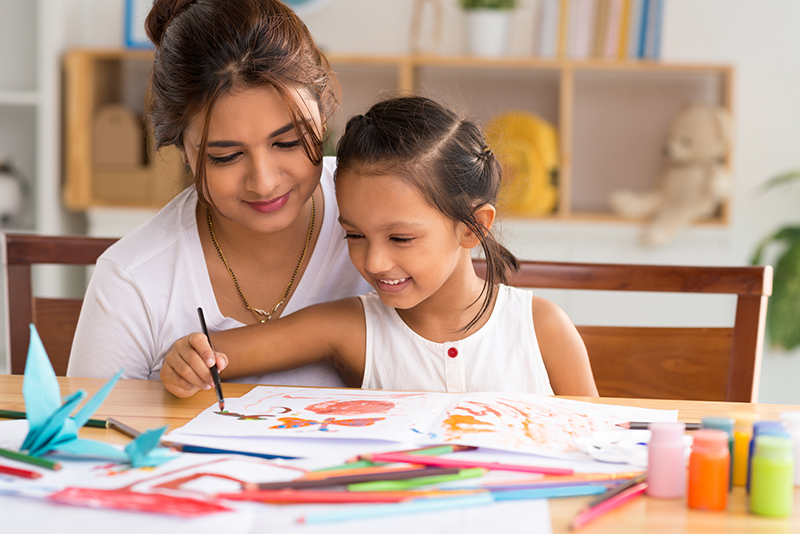Families For Life | Raising Bilingual Children: Options and Tips-Toddlers

Being ‘bilingual’ means being able to use two or more languages. Your decisions about raising bilingual children depend on your family situation and the languages you use at home.
Raising bilingual children: your family’s options
If you and/or your spouse speak languages other than English at home, your decisions about helping your children learn to use your native languages will depend on your family situation.
Here are the main models for raising bilingual children.
Option 1 for bilingual children: one person-one language
If you and your spouse speak different native languages, the one person-one language model for supporting bilingualism might be helpful for you.
For example, if your native language is English and your spouse’s is Mandarin, you speak English to your children and your spouse speaks Mandarin to them.
This model can work with more than one language other than English. For example, if your native language is Mandarin and your spouse’s is Tamil, you each speak your own native language to your children at home. Your children also learn to use English at school and in the community.
If you want your child to grow up fluent in your native language, you and your spouse must each consistently use your native language with your child – rather than swapping between languages. So if you speak Mandarin and you want your child to grow up being able to speak and understand Mandarin with a broad vocabulary, you’ll need to speak only Mandarin to your child.
The one person-one language model can help you both connect with your children in your own languages. Your children get to hear and speak both languages too.
It’s ideal if you both understand each other’s languages so neither of you feels left out when you speak your native language to your child.
Option 2 for bilingual children: minority language pattern
You might use the minority language pattern of supporting bilingualism if you and your spouse both speak the same native language in your family home.
For example, you might have migrated from India to Singapore and speak Tamil to your children at home. Tamil is the minority language. Your children also go to school and speak English with their friends and teachers.
Another example is if you and your spouse have hearing impairments and you’re raising a hearing child. Your child learns sign language at home, and English in the hearing community.
Or you might not be deaf, but you’re raising a child with profound hearing loss. Here your child is the minority language user. But you can give your child lots of exposure to the minority language by making sure your child uses sign language with other signers in the deaf community. This will help your child feel a sense of belonging, self-worth and pride about identity.
The minority language model means that your children hear, speak and use your native language a lot at home, because you and your spouse are using it.
If you feel pressure to stop speaking your native language with your children at home, it might help to know that raising bilingual children has many benefits. If your children know your native language and can use it well, it can make it easier for them to learn English as a second language.
Raising bilingual children: tips
Here are some practical tips for supporting your child’s bilingual development:
Play and games
Read and tell stories in your native language, and encourage your child to join in. Use dress-ups and be creative!
Play games in your native language – for example, ‘I spy’, bingo or memory.
Sing songs, dance and play music in your language. Children love music, and melody is a great way to help them remember things.
Community activities
Look for schools, child care centres or bilingual programmes that support your child’s use of your native language.
Organise playtime with other children who speak the same minority language.
Organise visits to or from speakers of the minority language. If it’s possible for you, visiting countries where people speak your minority language always boosts children’s interest in the culture and ability to speak the language.
Go to the library and borrow CDs, DVDs, picture books, junior fiction and magazines in your first language.
Look out for cultural activities that you and your child can do together to tap into your family’s cultural heritage and identity. For example, Racial Harmony Day in July is widely celebrated in schools each year.
At home
Listen to radio programmes in your first language, including popular music programmes and channels for teenagers.
Think about what your child is interested in – for example, soccer, music, TV shows, cooking and so on. Try incorporating your native language into these interests. For example, you could find your child’s favourite recipe or a typical recipe from your community and cook it together using only your native language.
Stick with your language choice, and give your child plenty of opportunities to listen to and speak this language.
Don’t give up! Some days it might seem like your child doesn’t want to speak in your native language. But just hearing you speak your native language will help your child learn it.
Speaking of Children II: Dr Mukhlis on Strategies for Raising a Bilingual Child
In this video, Dr. Mukhlis explains how to go about raising a bilingual child. His advice: encouragement and consistent exposure to both languages! Watch on to find out more.
© raisingchildren.net.au, translated and adapted with permission
Explore more